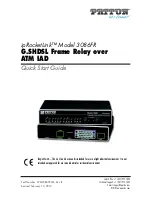
P
P
r
r
o
o
-
-
B
B
e
e
l
l
L
L
t
t
d
d
T
T
e
e
c
c
h
h
n
n
i
i
c
c
a
a
l
l
m
m
a
a
n
n
u
u
a
a
l
l
H
H
U
U
-
-
F
F
r
r
e
e
e
e
w
w
a
a
y
y
R
R
S
S
4
4
2
2
2
2
3
3
1
1
I
I
n
n
t
t
r
r
o
o
d
d
u
u
c
c
t
t
i
i
o
o
n
n
This manual covers the theory of operation and installation of the Freeway RS422
router card. The addition of this module to the Freeway product range gives
considerable flexibility to new and existing router systems, giving the ability to route
control signals with the associated video and audio signals within a single matrix
frame. The Freeway RS422 router improves upon the conventional RS422 router
design by using configurable ports, rather than fixed destination and source
connections; either controller or machine type hardware may be connected to any
port, which will configure itself according to the route made. This concept is further
extended to allow ‘distributive’ routing, so that a single controller can control several
machines, such a configuration is called a Broadcast Router.
The RS422 router card supports 32 ports, and allows expansion, using a further three
cards, to 128 ports, within a single Freeway frame. Details of the RS422 router
configuration and methods of control are held in the Freeway control card database,
which must contain data on any other routers within the Freeway system. Details on
configuring this database via the Windows based editor are contained in the Freeway
Editor Users Guide.
n
n
1
1
.
.
1
1
R
R
S
S
4
4
2
2
2
2
s
s
i
i
g
g
n
n
a
a
l
l
r
r
o
o
u
u
t
t
i
i
n
n
g
g
RS422 is the name given to a type of digital control signal used extensively in
broadcasting and post production environments. Typical uses of RS422 signals are
for machine control, such as for VTRs and Video Servers; and for connecting
hardware such as router control panels, Under Monitor Displays or computer serial
ports. The signal consists of data travelling in two directions (‘bi-directional’), and
each signal is balanced on two wires, to enable transmission over long distances
without interference.
RS422 control signals are bi-directional in order to allow commands from a controller
to be acknowledged by the device under control. Controllers rely on these responses
to confirm that a command has been received, or to report failures or errors.
A signal type known as RS485, or Multidrop, can also be routed, this is particular
type of RS422, which is capable of addressing up to sixteen independent pieces of
hardware ‘daisy chained’ onto one cable; this format is used extensively by Pro-Bel
for connecting control panels and UMDs.




































